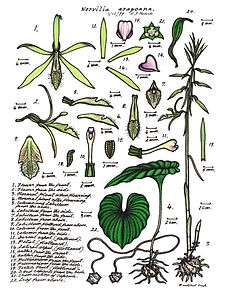Nervilia concolor
| Tall shield orchid | |
|---|---|
| Nervilia concolor in the Tsukuba Botanical Garden | |
| Scientific classification | |
| Kingdom: | Plantae |
| Clade: | Angiosperms |
| Clade: | Monocots |
| Order: | Asparagales |
| Family: | Orchidaceae |
| Subfamily: | Epidendroideae |
| Genus: | Nervilia |
| Species: | N. concolor |
| Binomial name | |
| Nervilia concolor | |
| Synonyms[1] | |
| |
Nervilia concolor, commonly known as the tall shield orchid[2] and as Nervilia aragoana in Australia[3] is small terrestrial orchid found in South and Southeast Asia and in northern Australia. It has pale green, short-lived flowers with a cream-coloured or yellowish labellum and a more or less circular leaf which emerges at the base of the flowering stem after flowering.

Description
Nervilia concolor is a terrestrial, perennial, deciduous, sympodial herb which grows in colonies with only a few individuals producing flowers in any one year. Between two and six pale green flowers 35–40 mm (1–2 in) long and 30–35 mm (1.2–1.4 in) wide are borne on an erect flowering stem 200–350 mm (8–10 in) tall. The sepals are 17–24 mm (0.7–0.9 in) long and about 2 mm (0.08 in) wide and the petals are similar but slightly shorter. The labellum has three lobes and is cream-coloured or yellowish with hairy purple or green veins. The side lobes curl inwards and the middle lobe has wavy edges and three hairy ridges. The flowers only last up to four days, following which a single leaf develops, including on those plants that did not flower. The leaf is bright green, heart-shaped or kidney-shaped but appears almost circular, 150–250 mm (6–10 in) in diameter with wavy edges and prominent radiating veins. In Australia, flowering occurs between September and December after heavy rain but in areas north of the equator in April and May.[2][4][5]
Taxonomy and naming
The tall shield orchid was first formally described in 1825 by Carl Ludwig Blume who gave it the name Cordyla concolor and published the description in Bijdragen tot de flora van Nederlandsch Indië.[6] In 1825 Rudolf Schlechter changed the name to Nervilia concolor.[1] The specific epithet (concolor) is a Latin word meaning "coloured uniformly".[7]
In Australia the species is known as Nervilia aragoana, first described in 1827 by Charles Gaudichaud-Beaupré.[8]
The species is known by a variety of vernacular names in Asia:
- Malaysia: Daun sa-helai sa-tahun, daun satu tahun (Peninsular).
- Thailand: Phaen din yen (Chiang Rai), waan phra chim (Bangkok).
- Vietnam: Ch[aa]n tr[aa]u xanh, thanh thi[ee]n q[uf]y, Ian c[owf].
- Japan: Yaeyama-kuma-sô, aoi-bokuro[9]
Distribution and habitat
Nervilia concolor occurs in Nepal, Bhutan, eastern India, Myanmar, Indochina, southern China, Taiwan, southern Japan, Thailand, the Malaysian region, the Pacific Islands, Queensland and the Northern Territory. It grows in forest, rainforest and monsoonal rainforest.[2][9]
References
- 1 2 3 "Nervilia concolor". World Checklist of Selected Plant Families (WCSP). Royal Botanic Gardens, Kew.
- 1 2 3 Jones, David L. (2006). A complete guide to native orchids of Australia including the island territories. Frenchs Forest, N.S.W.: New Holland. p. 281. ISBN 978-1877069123.
- ↑ "Nervilia aragoana". APNI. Retrieved 16 August 2018.
- ↑ "Nervilia aragoana". India Biodiversity Portal. Retrieved 16 August 2018.
- ↑ "Nervilia aragoana". trin keys. Retrieved 16 August 2018.
- ↑ "Cordyla concolor". World Checklist of Selected Plant Families (WCSP). Royal Botanic Gardens, Kew.
- ↑ Brown, Roland Wilbur (1956). The Composition of Scientific Words. Washington, D.C.: Smithsonian Institution Press. p. 227.
- ↑ "Nervilia aragoana". APNI. Retrieved 20 June 2017.
- 1 2 "Nervilia concolor". GLOBinMED. Retrieved 16 August 2018.